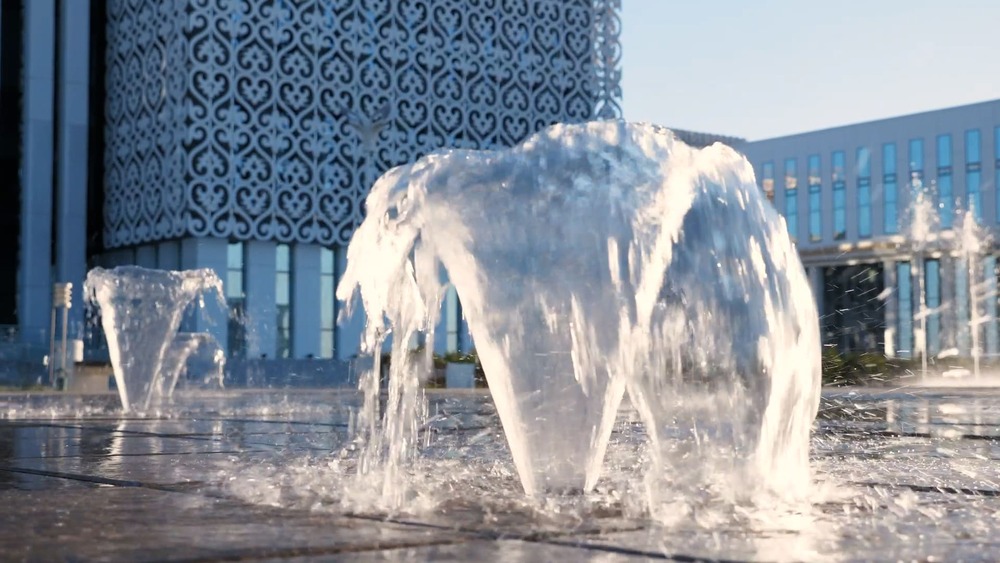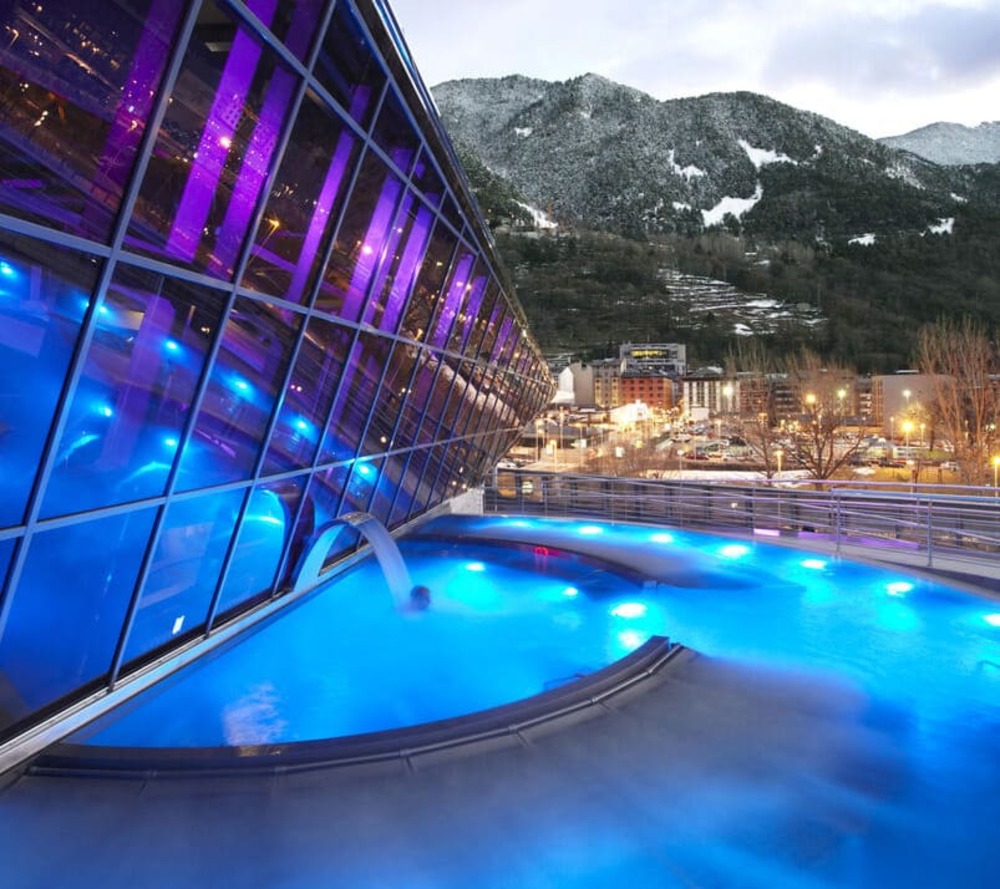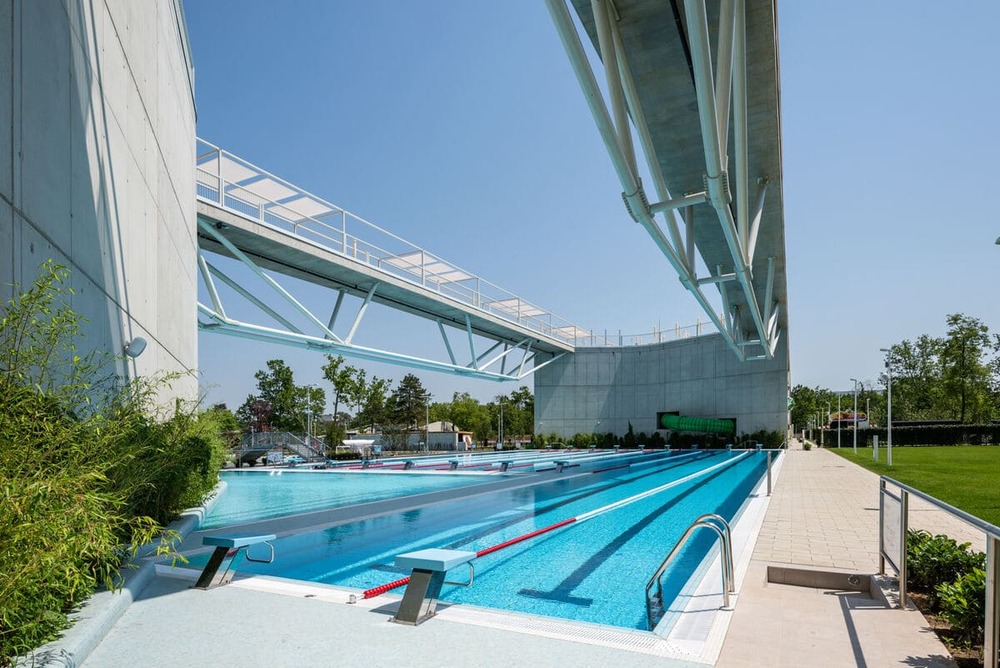A blend of utility and aesthetics, architectural water features harness the unique capacities of water to build refined, calming and refreshing spaces
Architectural water features are capable of channeling the tranquility, luxury, and vibrant energy of flowing water to any architectural design.
The fact is architectural water features transcend simple ornamental roles: they are functional, aesthetic, and experiential pieces, offering an outstanding potential to elevate both commercial and residential environments.
From serene ponds to dramatic fountains, luxurious wellness spas and expansive artificial lagoons, thoughtfully incorporating water design into architecture has the potential to transform an ordinary space into an extraordinary experience.
As such, here’s a look at the most advanced architectural water features today and how to integrate them into a successful project.
Dive deeper with the eBook
What are architectural water features?
Architectural water features refer to purposefully designed aquatic installations that are integrated into built environments.
Part of the distinct discipline of aquatic architecture, their history spans thousands of years. In this time, evolving aesthetics and engineering skills have shaped architectural water features, allowing designers to incorporate the aesthetic and functional value of water within constructed spaces.
As such, common examples of architectural water features include:
Fountains: Classic or modern installations that add motion, sound, and visual interest.
- Swimming pools: Recreational or decorative, pools bring luxury and leisure opportunities to any setting.
- Ponds and water mirrors: Naturalistic or geometric designs that create tranquil focal points.
Artificial lagoons: Man-made bodies of water designed for aesthetics, recreation, and cooling effects.
- Wellness spas: Hydrotherapy pools, hot tubs, and saunas that support health and well-being.
Water walls and streams: Dynamic water flows that add movement and acoustic ambiance.
The goals of such varied architectural water features stretch from enhancing an area’s visual appeal, to supporting practical functions or promoting a relaxed ambiance.
As such, each type of water feature offers unique aesthetic and functional possibilities, especially when tailored to suit a project’s architectural style and environmental context.

5 benefits of architectural water features
Incorporating architectural water features into design projects brings a host of advantages into built environments.
1. Enhanced aesthetic appeal
Water adds a dynamic, ever-changing element to architecture.
Whether it’s the shimmering surface of a reflecting pool or the graceful arc of a fountain, water introduces texture, movement, and light reflection, thus enhancing the visual richness of a space.
2. Promotes relaxation and wellness
The sound of flowing water reduces stress and induces a calming effect, as explored by scientific papers such as ‘Waterscapes for Promoting Mental Health in the General Population’ by Zhang et al. This opens the door to understanding architectural water features as a unique tool for creating tranquil environments with therapeutic potential, whether in hotels or resorts as well as healthcare facilities.
Additionally, hydrotherapy features in wellness spaces and spas are at the heart of innovative water therapies, including watsu therapies as an innovative wellness offering.
3. Increased property value
High-end architectural water features such as swimming pools, spas, and artificial lagoons can significantly boost the revenue and market value of commercial properties. At the heart of this drive is these features’ potential to become the main leisure offering and key selling points in real estate, attracting customers, discerning buyers and tenants.
4. Natural cooling and humidity control
In warmer climates, architectural water features contribute to creating fresh microclimates by facilitating cooling through evaporation. A type of passive cooling that is capable of reducing ambient temperatures and creating comfortable outdoor spaces in urban settings or hospitality landscapes.
A key example here are architectural projects that incorporate fountains as part of urban areas: these spaces help mitigate the ‘urban heat island’ effect generated in cities, while also serving as an oasis for citizens to rest, cool off, and build community.
5. Environmental and ecological benefits
When designed sustainably, water features such as ponds and lakes can become crucial allies for supporting biodiversity by attracting birds, insects, and aquatic life.
Green design practices here involve advanced systems where state-of-the-art technology meets natural and circular models for sustainable design: from rainwater harvesting systems and water recycling systems, to biofiltration and the use of native aquatic plants. The resulting architectural features present a high ecological value with a reduced environmental impact.
The distinct benefits of architectural water features for commercial facilities
A high-end hotel that installs an infinity-edge swimming pool overlooking a cityscape; a shopping mall that opts for interactive fountains to attract customers and create a vibrant atmosphere; a corporate campus that integrates a cascading water wall in its main lobby… All of them are harnessing the potential of architectural water features to serve both functional and branding purposes.
In this context, hotels and resorts can implement these features to evoke a striking first impression that evokes luxury and refinement. For office complexes, on the other hand, these features are leveraged to foster employee well-being, while other commercial areas see how they improve customer engagement in the area.
In the case of wellness centers, gyms, and spas, hydrotherapy elements are able to offer a unique therapeutic value, differentiating operators’ services in an increasingly competitive market.
All in all, these features become key contributors to a space’s identity and user experience, thus representing a smart investment for commercial developers.

Keys for integrating water features in landscaping projects
Successfully incorporating architectural water features into landscaping requires a thoughtful blend of aesthetics, engineering, and environmental awareness.
A process that requires a multi-disciplinary, detail-oriented approach where water feature professional designers should be involved, the overarching structure of such a project often includes the following steps:
1. Understanding the site and its environment
The process starts by assessing site conditions including topography, sunlight, wind patterns, and water availability. As a general rule, architectural water features should aim at harmonizing with the natural landscape and architectural style of choice.
From there, the options are many: from a Zen-inspired koi pond for a minimalist garden to a cascading rock waterfall for a rustic lodge, successful projects are about ensuring a cohesive identity with the overall project.
2. Using water as a focal point
Create visual interest by positioning water features at key viewpoints, such as entrances, courtyards, or outdoor seating areas. In commercial settings, large fountains or sculptural pools often act as landmarks or gathering points.
3. Achieving a balance between form and function
Successful projects are those where water features are matched to the intended use of the space. For instance, a resort may prioritize large swimming pools and wellness spas; meanwhile, a corporate campus might be more interested in incorporating sleek water walls and reflecting mirror pools for a modern, professional ambiance.
4. Ensuring sustainability
Today, there are many options to ensure architectural water features remain an environmentally friendly installation. Some key decisions here could include:
- The use of energy-efficient pumps and LED lighting to reduce energy consumption and, additionally, minimize operational costs.
- Incorporating reclaimed water or water recycling systems to avoid unnecessary resource wastes.
- Including native aquatic plants to both help maintain water quality and support biodiversity.
5. Technology and automation for enhancing control
In modern water features, lighting, temperature, and water treatment are no longer manually operated, but instead benefit from smart control systems and cutting-edge hydraulic equipment.
By incorporating automated features, it’s possible to reduce maintenance needs while also enhancing the user experience, as automation ensures a thorough treatment for totally clean water.

FAQs about architectural water features
What is considered an architectural water feature?
An architectural water feature is any element within a built environment that has been designed to incorporate water in order to enhance the area’s aesthetics and ambiance, or due to its functionality.
Fountains, reflecting pools, waterfalls.. These features can take diverse forms and serve a multitude of purposes.
Is it good to have a water feature inside the house?
As seen across the article, architectural water features can bring a host of advantages to a built environment: from creating an interesting visual point, to enhancing ambiance and promoting calming sensorial experiences, as well as cooling the area.
To truly enhance any space, however, it’s important to acknowledge architectural water features require thoughtful design and regular care.
Architectural water features to elevate commercial projects and align them with current experiential design trends
As sustainability and experiential design gain prominence across the globe, water remains one of the most powerful elements in shaping meaningful and memorable spaces.
From subtle reflecting pools to elaborate wellness spas, architectural water features are thus playing a transformative role in modern design, aligned with contemporary trends and elevating any project.
Through them, sensory experiences can be crafted that connect people with nature while enhancing aesthetics, promoting relaxation, and increasing property value.
Whether you’re planning a serene residential garden or a dynamic commercial plaza, incorporating water thoughtfully into your architectural design can elevate both its form and function.
In this quest, Fluidra’s expertise in developing aquatic commercial solutions represents a key ally for an impactful and successful implementation of architectural water features.
